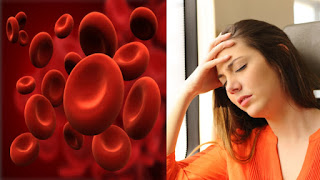What is anemia?
Anemia is the deficiency of hemoglobin or red blood cells in the blood. In this disease, the level of blood cells in the body is less than normal. Anemia occurs mostly in women and one of the main reasons is menstruation of women. Anemia is usually referred to as anemia when there is less than 13.5 grams of hemoglobin in men and less than 12 grams of hemoglobin in women. Due to Pitta Pradhan Tridosha in rasa-raktadi metals, relaxation occurs in the nutritional order of metals. Due to defects, the properties of forces, colors, and oases begin to wane. As a result, anemia occurs. As a result, anemia is produced.
Types of anemia:
Anemia due to iron deficiency: Anemia due to iron deficiency is a common type of anemia that usually occurs when there is excessive blood loss due to menstruation for a long time. Anemia can also occur due to iron deficiency due to the development of the fetus in pregnancy and the need for iron in children in childhood and adolescence.
Fanconi anemia or FA is a genetic blood disorder that can lead to bone marrow failure. FA is a type of aplastic anemia that does not allow bone marrow to form new blood cells. Due to FA, the bone marrow makes many abnormal blood cells. This can lead to serious diseases such as leukemia.
Pernicious anemia: In Pernicious anemia, the body does not make enough red blood cells because the body does not have enough vitamin B12 (the nutrient found in food). People who have Pernicious anemia are unable to absorb enough vitamin B12 due to a lack of one type of protein in the body. Vitamin B12 deficiency can also be caused by a number of conditions and factors.
Aplastic anemia: Aplastic anemia is a blood disorder that causes the marrow of the bones of the body to not make enough blood cells. This can lead to many health-related problems such as arrhythmias (abnormal heartbeat), increased heart size, heart failure, cramping, and bleeding. It develops suddenly or slowly and becomes severe over time until it is treated.
Hemolytic anemia: Hemolytic anemia occurs when red blood cells are destroyed or not in the bloodstream before the normal life span ends. The body can destroy red blood cells due to many diseases, conditions, and factors. Hemolytic anemia can cause many serious health problems such as fatigue, pain, arrhythmias (Arrhythmias; abnormal heartbeat), increased heart size, and heart failure.
Thalassaemias: Thalassaemias is a genetic blood disorder that causes the body to produce fewer red blood cells and hemoglobin (an iron-rich protein in red blood cells). The major types of Thalassaemias are Thalassaemias and Beta Thalassaemias. The severe type of Thalassaemias is called Alpha Thalassaemias Major or Hydrops Fetalis and the severe type of Beta Thalassaemias is called Beta Thalassaemias Major or Thalassaemias Anemia (Coole’s). Thalassaemias occurs in both men and women.
Sickle Cell Anaemia: Sickle Cell Anemia is a serious disease in which the body produces red blood cells resembling the sickle (sickle). Normal red blood cells have a disc-like shape, due to which it passes easily through the blood vessels. Red blood vessels contain a protein called hemoglobin (an iron-rich protein that gives the blood its red color and carries oxygen from the lungs to other parts of the body).
Causes of anemia:
The most important reason is not to consume proper amounts of things containing iron.
* After malaria, which causes red blood loss.
* Blood loss due to any reason, such as-
-Body bleeding (excessive bleeding in an accident, injury, wound, etc.)
– Bleeding with defecation, vomiting, cough.
– Excessive bleeding during menstruation.
* Bloody diarrhea due to stomach worms and parasites.
* Bleeding from stomach ulcers.
* To conceive again and again.
Symptoms of anemia:
Fatigue:
The first sign of anemia is fatigue. In this fatigue, your bones will be tired. If this happens to you, consult a doctor immediately.
Yellowing of the eyes:
If the eyes turn yellow, then this is the best way to know about anemia. You look at the mucous membrane of your eye, it is a vascular area so if it is yellow, it is a true indication that you are not getting enough red blood cells in other areas of your body.
Tension:
If you are absolutely stressed. Not only this, your heart starts beating fast. So understand that you have this problem.
Headache:
Tension, migraines, and headaches are common, but headaches continue to recur. If it is not reduced with this, then understand that it is happening due to lack of blood.
hair fall:
According to the American Academy of Dermatology, 80 million men and women experience hereditary hair loss. If you see more hair in your brush or your hair is thinner, then you may be anemic. It can also be a hormonal condition like a vitamin deficiency or hypothyroidism, so go to your doctor.
Numbness :
Numbness of hands and feet by sitting continuously is a common problem. Many times, eating and eating less, the liver does not work properly, intoxication, etc., and even hands and feet become numb. All the causes here are due to lack of blood.
Read More –
ACIDITY ! गैस का बनना, एसिडिटी बनने के कारण
मस्सा क्या होता है? : कारण, लक्षण और प्रकार
STOMACH ULCER ! पेट का अल्सर, गैस्ट्रिक अल्सर, अल्सर क्या है
ENCEPHALITIS (इंसेफेलाइटिस ) दिमाग की सूजन कारण और लक्षण
CERVICAL SPONDYLITIS, गर्दन का दर्द , सर्वाइकल स्पॉन्डिलाइटिस के कारण और लक्षण
COLITIS : आंतों में जख्म, सूजन, इन्फेक्शन के कारण और लक्षण
WHAT IS CONSTIPACTION? : कब्ज के कारण और लक्षण
LYMPHATIC FILARIASIS (ELEPHANTIASIS): SYMPTOMS, CAUSES AND CURRENT TREATMENT FOR FILARIASIS
CARDIOVASCULAR DISEASES: CAUSES, SYMPTOMS & TYPES
WHAT IS FILARIASIS? – SYMPTOMS, CAUSES, TREATMENT & TREATMENT

